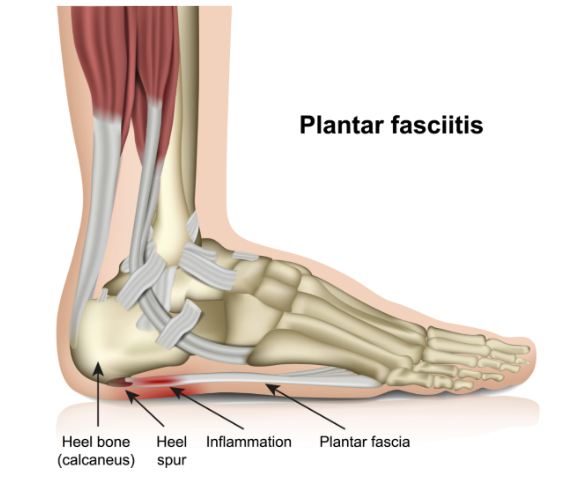What is plantar fascia pain?
The plantar fascia is a thick band of tissue that runs from the underneath the heal bone to the big toe. It is stretched as you push off the floor, during walking and running, and provides an energy saving, elastic recoil mechanism to push you forwards. The plantar fascia can become painful due to sudden changes in activity such as starting a couch to 5k, training for a marathon or even walking a few extra miles each day. It can affect both men and women of any age and can last for many months. Most people describe early morning pain when stepping out of bed, pain when moving after a prolonged period of rest and during and after walking or exercising. When the plantar fascia becomes repeatedly irritated (known as plantar fasciitis) the healing process can become affected resulting in a compromised plantar fascia. This is known as a plantar fasciopathy.
What are the symptoms of a plantar fascia pain?
- Pain in the heal with stepping out of bed.
- Pain in the heal with walking.
- Pain in the heal during and after exercise
- Pain in the heal with wearing flat shoes or walking barefoot.
What other local conditions can present like a plantar fascia pain?
- Morton’s neuroma
- Mid foot osteoarthritis
- Heal bursitis
- Achilles tendinopathy
- Baxter’s nerve entrapment
Plantar fascia vs Baxter’s nerve entrapment
A Baxter’s nerve entrapment refers to a pinching of a small nerve between two muscles of the foot (The first branch of the lateral plantar nerve also known as the Baxter’s nerve). This nerve runs along the inside of the heal and when pinched can cause sharp, burning pain, numbness and pins and needles around the inside of the heal. A Baxter’s nerve entrapment can occur after trauma or slowly without injury. It is not sex or age specific and can affect anyone at any time.
Plantar fascia pain can also gradually start without trauma but is often associated with a sudden change or increase in activity such as walking or exercise. Similarly plantar fascia pain can affect both men and women of any age.
Location and type of pain are important key diagnostic factors. Plantar fascia pain is located under the heal, both to touch and with contact with the floor. Symptoms of a Baxter’s nerve entrapment are sharp pain, numbness or pins and needles on the inner aspect of the heal and foot. Pain can be constant and also felt at rest.
What is the plantar fascia?
The plantar fascia is a strong fibrous band of tissue that sits underneath the foot. It runs from the heel to the big toe. It helps to propel you forward during both walking and running. It is the most common structure in the foot to suffer injury with over 10% of the population suffering at some time in their life.

How do I know if I have plantar fasciitis?
Plantar fascia pain is often described as a dull, throbbing or burning ache that is typically exacerbated when the plantar fascia is stretched after periods of prolonged rest.
Symptoms present gradually, commonly without trauma, and are often ignored for many months. Therefore, this typically presents as a chronic issue by the time treatment starts.
Typical symptoms include;
- Heel pain on stepping out of bed
- During walking
- Wearing flat shoes or walking barefoot
- When trying to exercise
How is plantar fasciitis diagnosed?
At Complete, our expert team of clinicians are able to accurately diagnose plantar fascia pain by using a series of clinical tests. We will assess your foot posture, ankle and foot mobility and muscle strength. These tests help us understand why you have developed plantar fasciitis in the first place and what treatment strategies are required to get you out of pain and back to full function as soon as possible. We may also assess your lower back, hips and knee to identify any the contributing factors.
It is important to obtain an accurate diagnosis to ensure optimum treatment provision. Heel spurs and local nerve irritation can manifest as plantar fasciitis. Therefore, a diagnostic ultrasound scan is completed as part of your initial assessment. Imaging is used to review the quality of the plantar fascia tissue, ensure an accurate diagnosis and to select the most appropriate treatment for you. The diagnostic ultrasound scan will also identify if you have sustained a tear in the plantar fascia. This normally occurs if you feel a sharp, sudden pain in the heel during an activity such as running for a bus, playing rugby or even just stepping off a curb. Certain treatment techniques such as a steroid injection or shockwave treatment may not be used if you have a tear and a period of immobilisation is often required.
How do I treat plantar fasciitis?
After your initial assessment, your physiotherapist will prescribe you a bespoke set of exercises; however, there here are a few initial self-management tips you may like to try:
- Resting from aggravating symptoms
- Calf stretching
- Calf raising strengthening exercises
- Trying an off-the-shelf insole for your shoe, known as an orthotic
- Rolling the bottom of your foot with a tennis or golf ball
If conservative treatments are not working, what do I do?
There are a few further treatment options available These include:
Extracorporeal Shockwave Therapy (ESWT)
ESWT is an effective, evidence-based treatment option for treating plantar fascia pain. It does this by desensitising irritated nerve endings and by causing controlled micro-trauma, triggering the body’s healing process. All clinicians at Complete are fully qualified to provide ESWT. This can be discussed with your clinician or by contacting us on 0207 4823875 or email info@complete-physio.co.uk.
Ultrasound-Guided Injection
If pain is persistent and nothing else is working, then a steroid injection may be required. A mixture of local anaesthetic and corticosteroid (a potent anti-inflammatory) is injected under the guidance of a real-time ultrasound scan. This is to ensure the plantar fascia is accurately targeted. Research has shown that guided injections are more accurate and are more effective at reducing pain than non-guided injections. Complete has a team of highly experienced physiotherapists and musculoskeletal sonographers. All are fully qualified to prescribe medication, scan and inject. For further information, please contact us on 0207 482 3875 or email injections@complete-physio.co.uk.
A referral to a podiatrist for a personalised orthotic (specialised inner sole for your footwear) can be arranged or in very rare cases an orthopaedic consultant for further imaging (MRI) and possible surgical opinion. Surgery is very rare for plantar fascia pain; however, if a heel spur is present, this may be required. These options can be discussed and arranged by your physiotherapist.



Leave A Comment